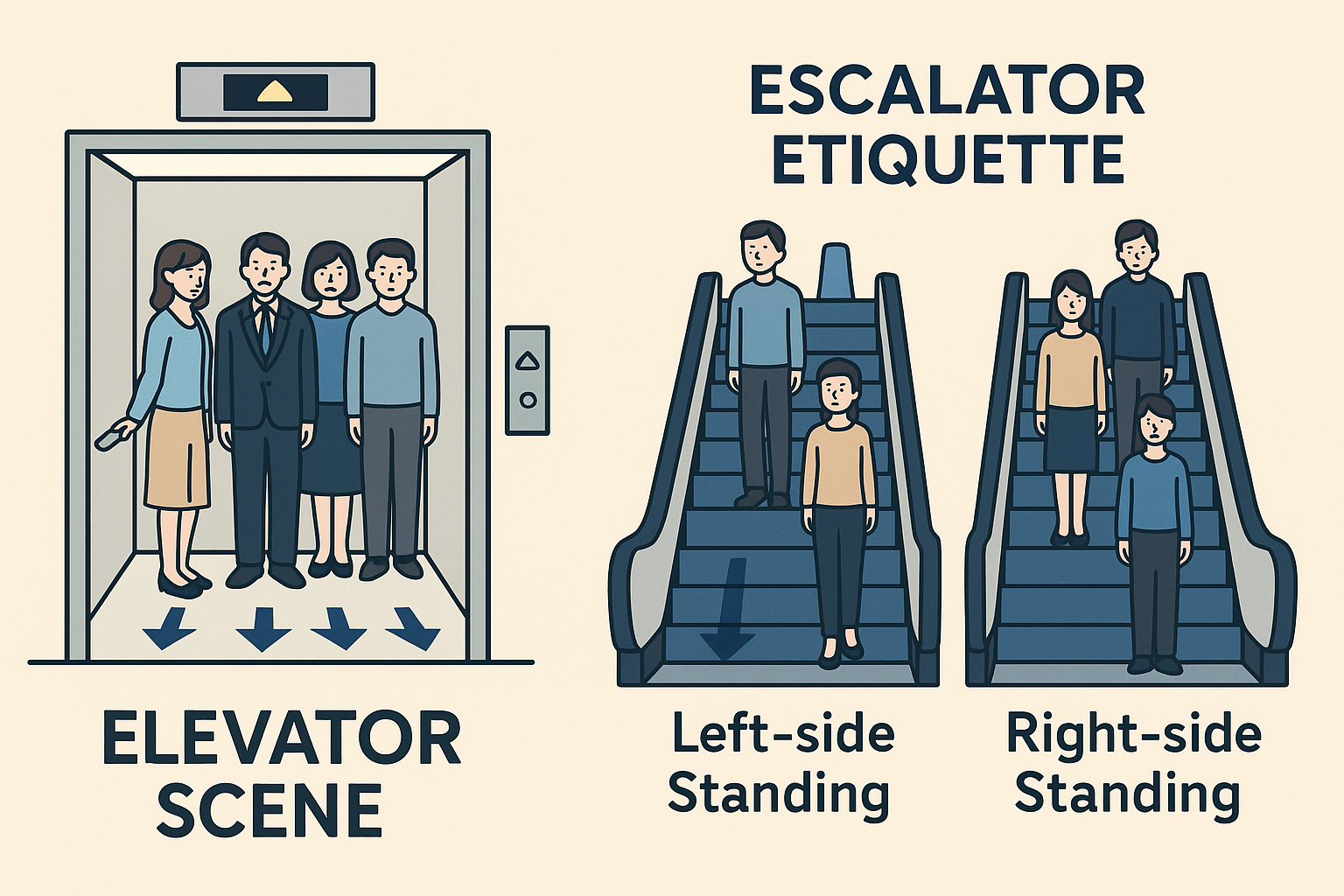
Japan is famous for its order, cleanliness, and quiet efficiency—and that mindset applies even to the way people use elevators and escalators.
If you’re traveling in Japan, you may be surprised at how calmly and carefully people use these everyday spaces. There’s an unspoken code of conduct that reflects Japanese values like respect, consideration, and group harmony.
Let’s explore how people use elevators and escalators in Japan, and how you, as a visitor, can navigate them smoothly.
🚪 Elevator Etiquette in Japan
✅ Who Stands Where?
Japanese elevator use is not random—it often follows an informal structure. People tend to stand in specific positions depending on how long they’ll be riding, and someone usually takes responsibility for pressing the buttons.
- Near the panel (front-right): This person is the “operator” by default. They hold the “Open” button when people enter or exit, and press “Close” once everyone is inside.
- Corners (back left/right): Occupied by those going to higher floors or who don’t need to get out soon.
- Near the door (front-left): People getting off soon stay near the front to exit easily.
While these roles aren’t assigned, people usually fall into them naturally, especially in business settings or elevators with many passengers.
🔇 Quiet and Considerate
Elevators in Japan are remarkably quiet.
No loud conversations, no phone calls, no small talk. It’s common to ride several floors in total silence. This reflects the Japanese tendency to minimize disturbance in shared spaces.
- Avoid using your phone inside the elevator
- Keep conversations low or wait until you exit
- Don’t eat or drink inside
- A small nod or soft “arigatou gozaimasu” when someone holds the door is polite, but not necessary
🔘 Open and Close Buttons Are Actually Used
In many countries, people ignore the “Open” and “Close” buttons. But in Japan, they’re used all the time.
- The person near the buttons often holds “Open” (開) while people enter
- Once everyone is in, they’ll press “Close” (閉) without saying anything
- This is part of being efficient and thoughtful
If you happen to be the person closest to the panel, taking on this small task is appreciated—even if you’re a visitor.
↕ Escalator Etiquette – Region by Region
Escalators are another place where Japanese order really shows—and it can vary depending on where you are in the country.
🗼 Tokyo and Eastern Japan:
- Stand on the left, walk on the right
- This is the standard in Tokyo, Yokohama, Sendai, and most of Kanto and Tohoku
- It allows people in a hurry to pass safely
🐙 Osaka and Western Japan:
- Stand on the right, walk on the left
- This is the opposite of Tokyo, and it often surprises first-time visitors
- Kansai people pride themselves on efficiency, and this rule reflects their regional character
🧠 Why the Difference?
The exact origin is debated, but one theory says that Tokyo’s system is modeled after the British (keep left), while Osaka developed its own “walk left” system during Expo ’70. Regardless, the pattern is deeply ingrained in both regions.
🛑 New Campaigns: “Don’t Walk on Escalators”
Recently, cities like Saitama, Kyoto, and Nagoya have started encouraging people to stand on both sides and not walk on escalators for safety reasons. You might see signs that say:
「エスカレーターでは歩かないでください」
“Please do not walk on the escalator.”
In those areas, follow the posted guidance—even if it feels counterintuitive.
(That said, many locals still walk anyway—old habits die hard.)
👪 Priority Use: Be Mindful of Others
Both elevators and escalators have priority considerations:
- Elevators may be marked for use by the elderly, disabled, or parents with strollers
- At stations, some escalators are wider for wheelchair access or labeled for “priority” use
- If you’re able-bodied, consider using stairs or escalators to leave elevators open for those who really need them
🙋♀️ What Should Visitors Do?
You’re not expected to follow every rule perfectly, but observing and adapting shows respect.
- On escalators: follow the local flow—left in Tokyo, right in Osaka
- On elevators: stay quiet, be aware of your position, press “Open” if near the panel
- If unsure: just observe others; Japanese people rarely say anything, but their actions are easy to follow
Japan’s elevator and escalator etiquette may seem overly detailed, but it reflects a culture that values harmony, efficiency, and care for others.
By following these simple rules, you can move through the country smoothly—and earn quiet respect along the way.
Even in transit, there’s grace in the Japanese way.